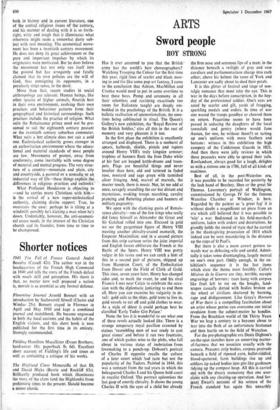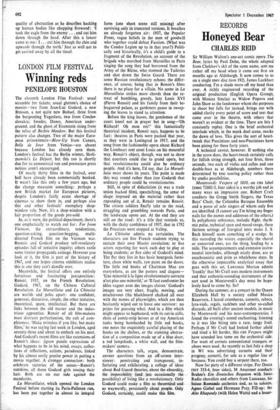Sword people ARTS
ROY STRONG
Has it ever occurred to you that the British - army has the world's best choreographers? Watching Trooping the Colour for the first time this year, rigid lines of scarlet and black mov- ing to and ffo like some pop art fantasy, I came to the conclusion that Ashton, MacMillan and Cranko would need to put in some overtime to beat these boys. Pomp and ceremony in all their relentless and ravishing exactitude (no room for Italianate tangle) are deeply em- bedded in the psychology of the British. It is a balletic realisation of unemotionalism, the emo- tions' being sublimated in ritual. The Queen's Gallery's new exhibition, the 'Royal Review of the British Soldier,' stirs all this in the rust of memory and very pleasant it is too.
In the first place the exhibition is excellently arranged and displayed. There is a sunburst of spears, halberds, shields, pistols and rapiers around Henry VIII's truly kingsize armour; trophies of banners flank the Iron Duke while at his feet are heaped kettle-drums and trum- pets. Flags are beautiful things and never lovelier than here, old and tattered in faded rose, mustard and sage green with tarnished silver fringing. Ahd, marvel of marvels, the master touch, there is music. Not, let me add'at once, savagely assaulting the ear but distant and mysterious, evoking troops marching, cavalry prancing and fluttering plumes and banners of military pageantry.
We open with the clanking gusto of Renais- sance chivalry:—one of the few kings who really did fancy himself as Alexander the Great and Sir Galahad rolled into one. Encased in gold we see the gargantuan figure of Henry VIII meeting another chivalry-crazed monarch, the Emperor Maximilian; and in a second picture from this strip cartoon series the joint imperial and English forces obliterate the French at the Battle of the Spurs. Henry VIII was pretty vulgar in his tastes and we can catch a hint of this in a second pair of pictures, shipped up from Hamphin Court, of the Embarkation from Dover and the Field of Cloth of Gold. This time, seven years later, Henry has changed sides and, to mark the event, he and his rival Francis I met near Calais to celebrate the occa- sion with the diplomatic junketi9g to end them all. Here you can examine his vulgarity in de- tail: gold sails to the ships, gold tents to live in, gold vessels to eat off and gold clothes to wear. As a style of decor it could perhaps best be classified 'Early Tudor Gin Palace.'
None the less it is wonderful to see what one of these revels actually looked like.. There is a strange temporary royal pavilion crowned by statues 'resembling men of war ready to cast great stones' and before it run two fountains, one of which gushes wine to the plebs, who fall about in various states of inebriation from lovemaking to a punch-up. Dobson's portrait of Charles II opposite recalls- the culture of a later court which had taste but not the popularity of the Tudors. Painted in 1644, this was a remnant from the sad years in which the beleaguered Charles I and his Queen held court in royalist Oxford. The portrait epitomises the last gasp of courtly chivalry. It shows the young Charles II with the eyes of a child but already
the firm nose and sensuous lips of a man; in the distance beneath a twilight of grey and rose cavaliers and parliamentarians charge into each other; above his helmet the roses of York and Lancaster are sadly about to shed their petals.
It is this glitter of festival and tinge-of nos- talgic romance that most take the eye. This is war in the days before conscription, in the hey- day of the professional soldier. One's eyes are sated by scarlet and gilt, yards of frogging, sparkling medals and orders. In time of war one waved the troops goodbye or cheered them on return. Peacetime seems to have been passed in seducing the daughters of the local townsfolk and gentry (where would Jane Austen, for one, be without them?) or tarting up one's uniform with more feathers and buttons: witness in this exhibition the high campery of the Coldstream Guards in 1821. And then there were jolly reviews in which these peacocks were able to spread their tails. Rowlandson, always good for a laugh, delights us with a riotous one in 1786, full of all kinds of sauciness.
Best of all, in the post-Waterloo era, it was possible to be recorded for posterity by the lush hand of Beechey, Shee or:the great Sir Thomas. Lawrence's portrait of Wellington, commissioned by George IV for the famous Waterloo Chamber at Windsor, is here. Regarded by the painter as 'a great fag' it is without doubt a magnificent set piece from an era- which still believed that it was possible to 'win' a war. Bedizened in his field-marshal's uniform, laden with orders and decorations, he grandly holds the sword of state that he carried in the thanksgiving procession of 1814 which indeed can be seen meandering in the distance up the steps of St Paul's.
But there is also a more covert gesture to- wards war as debasing,--vile and sordid. Admit- tedly it takes some disentangling, largely mental on one's own part. Oddly enough, in the ex- hibition's sequence it is the last items which state the theme most forcibly. Callot's Miseres de la Guerre are tiny, terrible, myopic engravings of horrors : trees hung with corpses like fruit left to rot on the boughs, land- scapes casually dotted with bodies broken on the wheel or civilians shattered by burning, rape and disfigurement. Like Goya's Horrors of War there is a compelling fascination about an artist whose genius can overcome our initial revulsion from the subject-matter he handles. From the Brechtian world of the Thirty Years War we leap a century to a bayonet about to tear into the flesh of an unfortunate Scotsman and then hurtle on to the field of Waterloo.
For the pre-photographic era Denis Dighton's on-the-spot sketches have an unnerving matter- of-factness that we associate usually with the camera. Peasants strip bodies, corpses protrude beneath a field of ripened corn, bullet-riddled, blood-spattered, farm buildings rise up and soldiers tip naked bodies into pits like gardeners tidying up the compost heap. All this is carried out with the dreary monotony that one asso- ciates with any clearing-up operation. And Ser- jsant Ewart's account of his seizure of the French standard has again this unearthly quality of abstraction as he describes hacking up human bodies like chopping firewood: took the eagle from the enemy ... and cut him down through the head. After this a lancer came at me : I ... cut him through the chin and upwards through the teeth.' Just as well not to get carried away by all the tinsel.



































 Previous page
Previous page